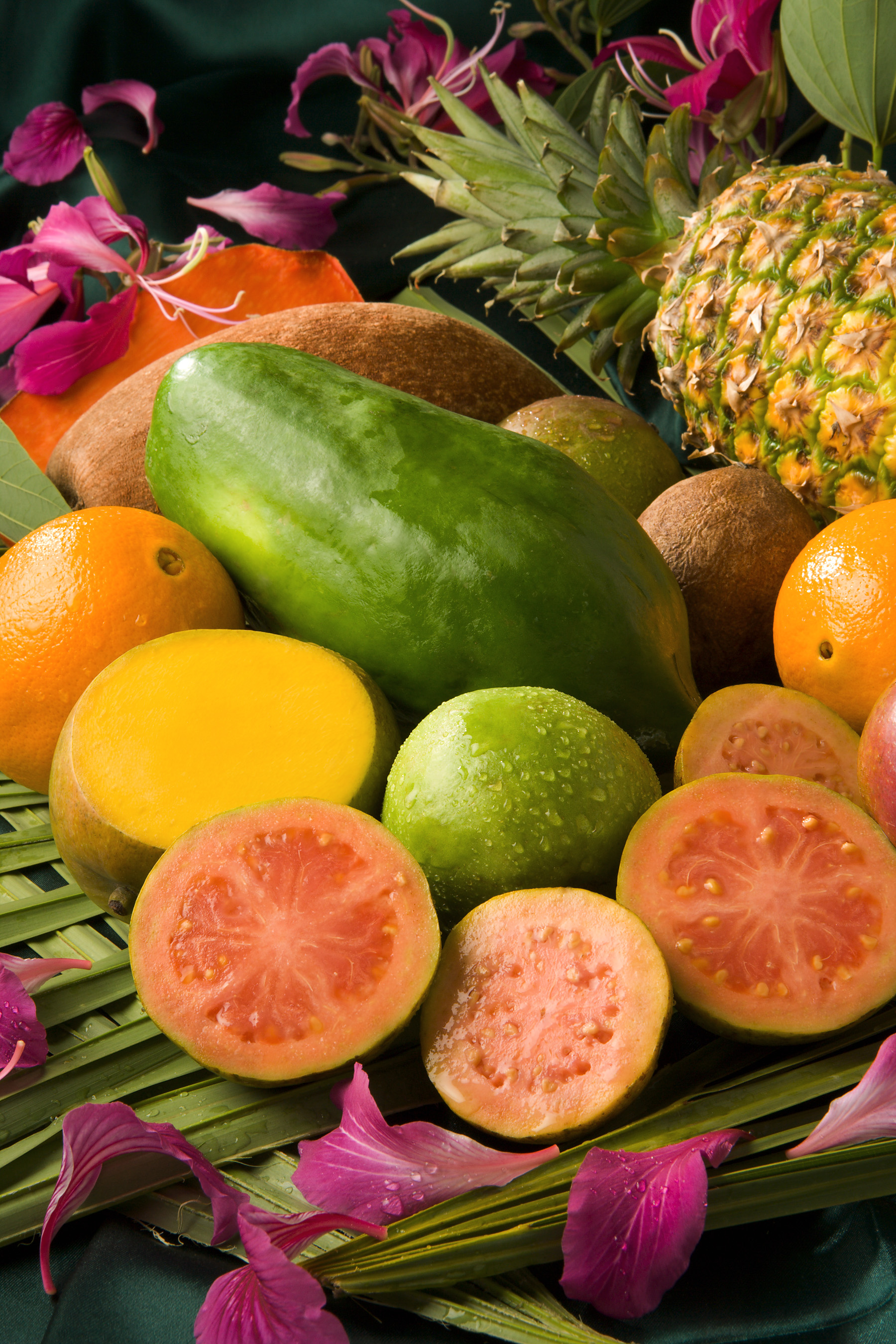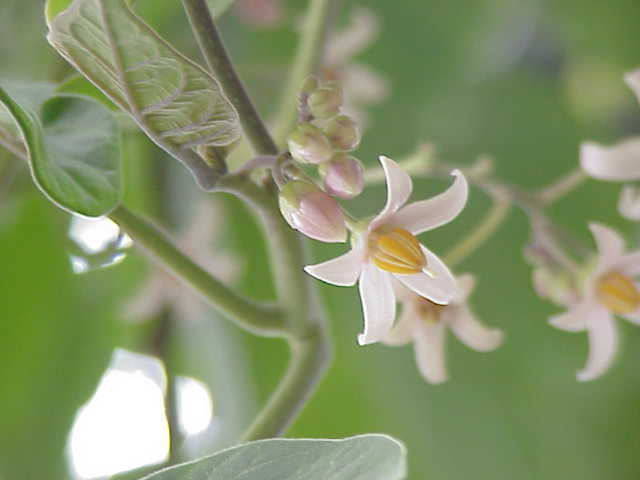|
Solanum Abutiloides
''Solanum abutiloides'' is a species of plant in the family Solanaceae. It is endemic to Argentina and Bolivia, and thrives as a weedy plant in rocky land, on stream banks, and scrub land between in elevation. It is also known as dwarf tamarillo, due to superficial similarities with ''Solanum betaceum''. Both plants are noted for very rapid growth from seed, and very strongly fragrant foliage. ''Solanum abutiloides'' is also sometimes known by the archaic ''Cyphomandra sibundoyensis''. ''Solanum abutiloides'' quickly matures into a shrub or small tree up to tall, though usually far smaller. Small flowers form on branches throughout the plant, and individual clusters of flowers can contain as many as 60 blooms. Blooms are followed by fruits - a small oblong berry that ripens to a yellow-orange color. The berries are around (or slightly larger) in diameter. When unripe, the berries are mildly toxic (as are tamarillos), though they are edible upon ripening. Uses The f ... [...More Info...] [...Related Items...] OR: [Wikipedia] [Google] [Baidu] |
August Grisebach
August Heinrich Rudolf Grisebach () was a German botanist and phytogeographer. He was born in Hannover on 17 April 1814 and died in Göttingen on 9 May 1879. Biography Grisebach studied at the Lyceum in Hanover, the cloister-school at Ilfeld, and the University of Göttingen. He graduated in medicine from the University of Berlin in 1836. He undertook expeditions to Provence, Turkey, the Balkans, and Norway. In 1837 he became associate professor and in 1847 full professor at the medical faculty in Göttingen and was named director of the botanical garden there in 1875. While his main fields of interest were phytogeography and systematics, especially the Gentianaceae and Malpighiaceae, he considered his ''Flora of the British West Indian Islands'' his most important work. Much of his collection, especially the types of species described by him, are housed at the Göttingen University Herbarium. His taxonomic classification is set out in his ''Grundriss der systematisc ... [...More Info...] [...Related Items...] OR: [Wikipedia] [Google] [Baidu] |
Aphid
Aphids are small sap-sucking insects and members of the superfamily Aphidoidea. Common names include greenfly and blackfly, although individuals within a species can vary widely in color. The group includes the fluffy white woolly aphids. A typical life cycle involves flightless females giving live birth to female nymphs—who may also be already pregnant, an adaptation scientists call telescoping generations—without the involvement of males. Maturing rapidly, females breed profusely so that the number of these insects multiplies quickly. Winged females may develop later in the season, allowing the insects to colonize new plants. In temperate regions, a phase of sexual reproduction occurs in the autumn, with the insects often overwintering as eggs. The life cycle of some species involves an alternation between two species of host plants, for example between an annual crop and a woody plant. Some species feed on only one type of plant, while others are generalists, c ... [...More Info...] [...Related Items...] OR: [Wikipedia] [Google] [Baidu] |
Tropical Fruit
A tropical fruit one that typically grows in warm climates, or equatorial areas. Tropical fruits Varieties of tropical fruit include: *Acerola ( West Indian Cherry or Barbados Cherry) *Ackee *Banana * Barbadine (granadilla; maracujá-açu in Portuguese) *Brazil nut *Breadfruit * Canistel *Carambola (star fruit or five fingers) *Cashew * Chenet ( guinep or ackee; pitomba-das-Guinas in Portuguese) * Cherimoya * Caimito (caimite; related to the yellow abiu - egg fruit) *Cocoa *Coconut *Coffee * Cupuaçu *Custard apple *Durian *Genipap * Governor's plum * Guaraná *Guava * Hog plum (taperebá in Portuguese) *Jackfruit * Longan *Lychee *Macadamia * Mamey sapote (mammee apple; abricó in Portuguese) *Mamoncillo *Mango *Mangosteen * Marang *Papaya *Passion fruit *Persimmon *Pewa (peach nut; pupunha in Portuguese) * Pili nut *Pineapple * Plantain *Pois doux (ice-cream bean; inga-cipó in Portuguese) *Pomegranate *Pommerac (Otaheite apple; Malay apple; jambo in Portuguese) *Pom ... [...More Info...] [...Related Items...] OR: [Wikipedia] [Google] [Baidu] |
Flora Of Bolivia
Flora (: floras or florae) is all the plant life present in a particular region or time, generally the naturally occurring ( indigenous) native plants. The corresponding term for animals is ''fauna'', and for fungi, it is '' funga''. Sometimes bacteria and fungi are also referred to as flora as in the terms ''gut flora'' or ''skin flora''. Etymology The word "flora" comes from the Latin name of Flora, the goddess of plants, flowers, and fertility in Roman mythology. The technical term "flora" is then derived from a metonymy of this goddess at the end of the sixteenth century. It was first used in poetry to denote the natural vegetation of an area, but soon also assumed the meaning of a work cataloguing such vegetation. Moreover, "Flora" was used to refer to the flowers of an artificial garden in the seventeenth century. The distinction between vegetation (the general appearance of a community) and flora (the taxonomic composition of a community) was first made by Jules Thurm ... [...More Info...] [...Related Items...] OR: [Wikipedia] [Google] [Baidu] |
Flora Of Argentina
The Environment of Argentina is characterised by high biodiversity. Biodiversity Subtropical plants dominate the Gran Chaco in the north, with the ''Dalbergia'' genus of trees well represented by Brazilian rosewood and the quebracho tree; also predominant the wacho white and black algarrobo trees ('' Prosopis alba'' and '' Prosopis nigra''). Savannah-like areas exist in the drier regions nearer the Andes. Aquatic plants thrive in the wetlands of Argentina. In central Argentina the ''humid pampas'' are a true tallgrass prairie ecosystem. The original pampa had virtually no trees; some imported species like the American sycamore or eucalyptus are present along roads or in towns and country estates (''estancias''). The only tree-like plant native to the pampa is the evergreen Ombú. The surface soils of the pampa are a deep black color, primarily mollisols, known commonly as ''humus''. This makes the region one of the most agriculturally productive on Earth; however, this is als ... [...More Info...] [...Related Items...] OR: [Wikipedia] [Google] [Baidu] |
Edible Solanaceae
An edible item is any item that is safe for humans to eat. "Edible" is differentiated from "eatable" because it does not indicate how an item tastes, only whether it is fit to be eaten. Nonpoisonous items found in nature – such as some mushrooms, insects, seaweed, and so forth – are referred to as edible. Processed items that normally are not ingested but are specially manufactured to be so, like edible underwear or edible packaging, are also labeled as edible. Edible items in nature It is estimated that approximately half of about 400,000 plant species on earth are edible, yet ''Homo sapiens'' consume only about 200 plant species, because these are the simplest to domesticate. Edible plants found in nature include certain types of mushrooms, flowers, seeds, berries, seaweed, and cacti. Being able to identify the versions of these plants that are safe to eat is an important survival skill. Many animals are also edible, including domesticated livestock as well as wild inse ... [...More Info...] [...Related Items...] OR: [Wikipedia] [Google] [Baidu] |
Whitefly
Whiteflies are Hemipterans that typically feed on the undersides of plant leaves. They comprise the family Aleyrodidae, the only family in the superfamily Aleyrodoidea. More than 1550 species have been described. Description and taxonomy The Aleyrodidae are a family in the suborder Sternorrhyncha and at present comprise the entire superfamily Aleyrodoidea, related to the superfamily Psylloidea. The family often occurs in older literature as "Aleurodidae", but that is a junior synonym and accordingly incorrect in terms of the international standards for zoological nomenclature. Aleyrodidae are small insects, most species with a wingspan of less than 3 mm and a body length of 1 mm to 2 mm. Many are so small that their size complicates their control in greenhouses because they can only be excluded by screening with very fine mesh; in fact they can enter mesh so fine that many of their natural enemies cannot come in after them, so that unchecked whitefly populatio ... [...More Info...] [...Related Items...] OR: [Wikipedia] [Google] [Baidu] |
Spider Mite
Spider mites are members of the Tetranychidae family, which includes about 1,200 species. They are part of the subclass Acari (mites). Spider mites generally live on the undersides of leaves of plants, where they may spin protective silk webs, and they can cause damage by puncturing the plant cells to feed. Spider mites are known to feed on several hundred species of plants. Description Spider mites are less than in size and vary in color. They lay small, spherical, initially transparent eggs and many species spin silk webbing to help protect the colony from predators; they get the "spider" part of their common name from this webbing. Life cycle Hot, dry conditions are often associated with population build-up of spider mites. Under optimal conditions (approximately 27 °C), the two-spotted spider mite can hatch in as little as 3 days, and become sexually mature in as little as 5 days. One female can lay up to 20 eggs per day and can live for 2 to 4 weeks, laying hund ... [...More Info...] [...Related Items...] OR: [Wikipedia] [Google] [Baidu] |
Solanum Betaceum
The tamarillo (''Solanum betaceum'') is a small tree or shrub in the flowering plant family Solanaceae (the nightshade family). It is best known as the species that bears the tamarillo, an egg-shaped edible fruit. It is also known as the tree tomato, tomate de árbol, tomate andino, tomate serrano, blood fruit, tomate de yuca, tomate de españa, sachatomate, berenjena, chilto and tamamoro in South America, and terong Belanda (Dutch eggplant) in Indonesia. It is popular globally, especially in Peru, Colombia, New Zealand, Ecuador, Rwanda, Burundi, Australia, Bhutan and the United States. Description Plant origin and regions of cultivation The tamarillo is native to the Andes of Ecuador, Colombia, Peru, Chile, Argentina and Bolivia. Today it is still cultivated in gardens and small orchards for local production, and it is one of the most popular fruits in these regions. Other regions of cultivation are the subtropical areas throughout the world, such as Burundi, Kenya, ... [...More Info...] [...Related Items...] OR: [Wikipedia] [Google] [Baidu] |
Friedrich August Georg Bitter
Friedrich August Georg Bitter (13 August 1873 – 30 July 1927) was a German botanist and lichenologist. Born in Bremen, he studied at the Universities of Jena, Munich and Kiel, earning his doctorate at the latter institution in 1896. Afterwards he performed assignments in Berlin. In his studies he was influenced by instructors such as Simon Schwendener (1829–1919), Friedrich Wilhelm Zopf (1846–1909) and Johannes Reinke (1849–1931). In 1905 he was named director of the botanical garden in Bremen. During the later part of his career he served as director of the botanical garden in Göttingen. He specialized in the botanical genus ''Solanum'', as evidenced by his ''Solana Africana'', a four-part monograph in which he provided descriptions of all known African ''Solanum'' species. In the field of lichenology, he conducted anatomical and developmental studies on the thallus Thallus (plural: thalli), from Latinized Greek (), meaning "a green shoot" or " twig", is the vege ... [...More Info...] [...Related Items...] OR: [Wikipedia] [Google] [Baidu] |
Bolivia
, image_flag = Bandera de Bolivia (Estado).svg , flag_alt = Horizontal tricolor (red, yellow, and green from top to bottom) with the coat of arms of Bolivia in the center , flag_alt2 = 7 × 7 square patchwork with the (top left to bottom right) diagonals forming colored stripes (green, blue, purple, red, orange, yellow, white, green, blue, purple, red, orange, yellow, from top right to bottom left) , other_symbol = , other_symbol_type = Dual flag: , image_coat = Escudo de Bolivia.svg , national_anthem = " National Anthem of Bolivia" , image_map = BOL orthographic.svg , map_width = 220px , alt_map = , image_map2 = , alt_map2 = , map_caption = , capital = La Paz Sucre , largest_city = , official_languages = Spanish , languages_type = Co-official languages , languages ... [...More Info...] [...Related Items...] OR: [Wikipedia] [Google] [Baidu] |





